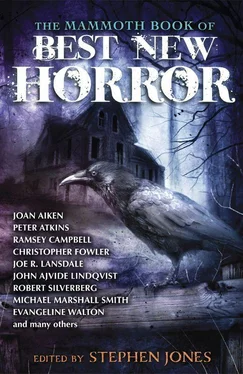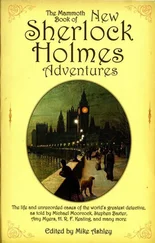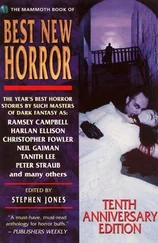To the left of the reception desk was the entrance to the restaurant and, beyond it, the sun corridor. Moving to the doorway, Mandeville saw immediately that sections of the intricate floor designed by Constance Priest were gone. Created by using nearly four thousand handmade tiles, its pattern should have covered the floor, an interlocking swirl of lines and blooms suggesting water, air and life. However, some of the tiles had been replaced by ones that only almost matched and whose colours, size or patterning was just off-kilter. Other tiles had been replaced by plain squares which cut into Priest’s patterns clumsily, disrupting its movement.
Mandeville sighed to see it.
Tables, cheap Formica models with spindle legs, were piled against the walls like the skeletons of long-dead animals. In the sunlight, the floor pattern and the shadows from the tables merged at the corners of the room, bleeding together in black clots.
The doors to the sun corridor were open and through them, Mandeville could see the grey ocean churning beyond its glass walls. He walked towards it, his feet crunching on the grit and dirt on the floor, and peered into the glass corridor.
A later addition to the Grand, running the length of its rear, the 1950s structure had suffered badly from neglect during the previous years. Streaks of rust crawled down the glass from metal struts that were losing an uneven battle against the corroding, salt-laden atmosphere. Several of the panes were broken and had been replaced by plywood sheets. More sheets lay piled against the seaward wall, having been removed from the windows at Mandeville’s request. Apart from the roof in the foyer, all the windows that had complete glass panes had been uncovered so that the Crew could work in daylight where possible.
Mandeville was about to leave the sun lounge when he noticed something beyond the glass. No, not beyond the glass, on it: swirls of colour, so incredibly pale as to be almost invisible, but present nonetheless. An arc of red and green straddled the pane nearest to him, blue and red in the next pane along.
Stepping close, he ran his fingers across the glass, leaving streaks along the surface. Looking at his fingertips, he saw that the ovals of grime below his nails also contained tiny flashes of colour. Paint? he wondered, sniffing at it. Had someone sprayed or splashed paint on the windows in the past and then tried to wipe it off? Vandalism? He would check with Parry, see if there was a record of that kind of damage; God alone knew what other problems they would come across in here.
Turning, he called for his colleagues.
Setting Up; Working the Hotel; Cataloguing
Parry, the Crew’s archivist and researcher, had set up in the foyer. Laid out across the floor were photocopies and typed sheets, indicating precisely what the Crew was to look for and where within the Grand it was, how it was made and the materials used. Where makers were known, this was indicated as well.
Yeoman, the architect, who had less to do in this initial phase, was setting up a base camp in the restaurant.
The Crew was staying in the hotel, sleeping in the open expanse of the empty dining area to save time. There was a lot to do, and they had only a week to do it before the owners wanted an initial report. In seven days, Mandeville had to be able to make recommendations about the order of jobs and which parts of the hotel’s original decorations could be preserved or restored and incorporated into the latest developments planned for the hotel. It was a big job, the biggest the Crew had taken on.
Mandeville was re-reading the initial site assessment carried out by the owner’s own assessors. There were a couple of areas in the hotel the Crew had been instructed to stay away from (the kitchen; not an issue as there was nothing in there for them to assess according to Parry, and a first floor bathroom whose floor was rotten but which Mandeville did want to check out if he could).
Up or down? he asked himself. Top or bottom first? Finally, he chose bottom simply because the closest of what Parry called his “Interest Lists” dealt with ground floor.
Taking the sheet of paper, Mandeville moved into one of the Grand’s lower corridors.
Parry was in the top corridor. Unlike Mandeville, the artist and restorer, or Yeoman the architect, Parry was a historian and he simply wanted to see what remained of the hotel’s past. Of course, the great delight in being part of the Save Our Shit Crew was that sometimes they could persuade those designers of the present and the future to save or incorporate the past into their plans.
Take this place, for example; the Ocean Grand. Originally owned by one of Britain’s smaller rail companies, the Grand was the crowning glory of the artists Howard Gravette and Marie Priest, and the only hotel they had ever designed. Working with the architect, Edward Manning, they had created a small, opulent establishment, intended for the moneyed classes. Its every element was part of a unified, intelligent whole, creating a unique holiday venue that had been popular in the periods just before and after the First World War.
Manning’s architecture and Gravette and Priest’s designs incorporated the ideas and principles of the art deco movement, blending them with, in particular, Gravette’s ideas of art as a reflection of what he called “the lived life”.
Aided by Priest’s skills in the use of pattern and intricate textile work, Gravette’s intense, layered artwork utilised images from both the natural and industrial worlds, turning the Grand into a building that was, in a review of the time, “simply astonishing” and which celebrated both mankind’s move towards an industrialised society and the supremacy of the natural world.
Guests in its heyday found themselves surrounded on the ground floor by designs that were solid, geometric, echoing the patterns found in the factories of the time. On the first and second floors, the designs became more fluid, twisting and losing their angles, and by the third floor, nature had taken over.
Here, every element of the decor and the original furniture had implied a triumphant natural world, burying the industrial world’s edges beneath the flows and sweeps of leaf and coastline and animal. The Grand was unique, and strangely subversive.
As he walked up the tattered staircase to the third floor, Parry couldn’t help but smile. Gravette and Priest had been lovers at the time of the hotel’s design and construction, and throughout the building elements of that sexuality, slipped in below the radar of the rail company executives, were apparent.
It wasn’t subtle even; Parry had seen photographs of the missing mural that had adorned the foyer. Across the four sections, a vast and dark locomotive had strained, its windows filled with pale and crammed faces. The train was, in the leftmost panel, erupting from a copse of twisting, stunted trees, and in the rightmost was burying itself into a tunnel whose dark brickwork was surrounded by a collar of white.
Celebrated at the time as a grand depiction of the reach and the power of the rail industry, it was in actuality, a huge cock disappearing into a vagina. The white collar was a not-very-subtle reference to Priest, the stunted trees Gravette’s own pubic hair. How had they missed it? mused Parry as he wandered the corridors. How had they not seen?
“So what’s left?” asked Mandeville that evening. A small lamp illuminated the three men; takeaway pizza boxes littered the floor between them. Around them, Parry’s lists were piled, now covered in notations and scrawled comments.
“The carpets are all gone,“ said Parry. “I can’t find any of the original designs. Most of the rooms have been refitted, so none of the original furniture’s left, although rooms 212 and 208 have the lamp fittings in the wall. The bathrooms on the second floor were torn out in the sixties, so we know that all that’s gone, but the suites on the third floor still have the original baths with the bath taps.”
Читать дальше










